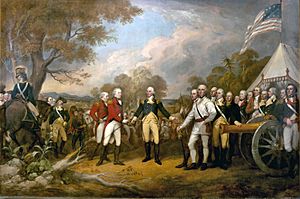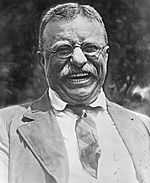History of New York facts for kids

The history of New York State began about 12,000 years ago. That's when the first Native Americans arrived. By 1100 AD, New York's main native groups, the Iroquoian and Algonquian, were well-established. European explorers from France first saw New York in 1524. The Dutch made the first land claim in 1609.
The Dutch colony, called New Netherland, was important for the fur trade. It later became a farming area thanks to a system called patroon system. In 1626, the Dutch bought Manhattan Island from Native Americans. In 1664, England took control and renamed the colony New York. This was in honor of the Duke of York (who later became King James II). New York City grew in importance during the 1700s. It became a major trading port in the Thirteen Colonies.
New York played a big part in the American Revolution and the war that followed. The Stamp Act Congress in 1765 brought together leaders from the colonies. They wanted to respond together to British rules. The Sons of Liberty group was active in New York City. They challenged British power. After losing the Battle of Long Island, the American Continental Army had to leave the New York City area. The British used the city as their main base for the rest of the war.
The Battle of Saratoga was a turning point for the Americans. It convinced France to become their ally. New York's own constitution was adopted in 1777. It greatly influenced the United States Constitution. New York City was the national capital at different times between 1785 and 1790. The Bill of Rights was written there. Albany became the permanent state capital in 1797. In 1787, New York was the eleventh state to approve the United States Constitution.
New York saw major transportation improvements in the 1800s. These included the first steamboat line in 1807. The Erie Canal opened in 1825. America's first regular train service started in 1831. These changes helped people settle western New York. They also created trade links with the Midwest around the Great Lakes.
During the American Civil War, New York City had strong trade ties with the South. Some people in the city even wanted to leave the Union. But New York State ended up sending the most soldiers and money to support the Union. After the war, the state helped start the industrial age. It was also home to some of the first labor unions.
In the 1800s, New York City became the main entry point for European immigrants. Many Irish people arrived during their Great Famine. Millions came through Castle Clinton before Ellis Island opened in 1892. Ellis Island welcomed millions more, especially from eastern and southern Europe. The Statue of Liberty opened in 1886. It became a symbol of hope for immigrants. New York boomed during the Roaring Twenties. Skyscrapers showed the city's energy. New York City had the tallest buildings in the world from 1913 to 1974.
Building defense industries for World War II helped New York's economy recover from the Great Depression. After the war, many people moved to suburbs around major cities. Most central cities became smaller. The Thruway system opened in 1956. This marked another time of transportation progress.
New York City faced financial problems in the late 1970s. But it later became a cultural center again. It attracted more immigrants and new music styles. The city grew from publishing to become a media capital. Many national news channels are based there. The state's factories closed down. New York shifted to service industries.
The September 11 attacks in 2001 destroyed the World Trade Center. Almost 3,000 people died. These were the largest terrorist attacks on United States soil.
Contents
- Early History of New York
- First European Explorers
- Dutch and British Take Control
- New York as a British Colony
- New York's Role in the American Revolution
- From Statehood to the Civil War
- New York During the Civil War
- From the Civil War to 1900
- New York in the Early 1900s and the Great Depression
- World War II and Modern New York
- New York in the Late 20th Century
- New York After September 11, 2001
Early History of New York
The first people arrived in New York around 10,000 BC. Around 800 AD, ancestors of the Iroquois moved into the area. The Point Peninsula Complex people were the ancestors of the Algonquian groups in New York. By about 1100 AD, the distinct Iroquoian and Algonquian cultures had formed. These were the groups Europeans later met.
The five nations of the Iroquois League formed a powerful group around the 1400s. They controlled land across present-day New York and into Pennsylvania. For centuries, the Mohawk people grew corn in the Mohawk River lowlands. Dutch settlers later bought this land. The Iroquois nations to the west also had farms and fruit trees.
The Iroquois controlled the fur trade in their territory. They traded with European colonists. Other New York tribes were often taken over by Europeans or by the Iroquoian group. The Iroquois were located between French and English settlements. This meant they were deeply involved with the Europeans. The settlers also depended on the Iroquois.
Algonquian tribes were less united. They usually lived along rivers or the Atlantic Coast. Both native groups had complex cultures. They had a rich economy that included hunting, gathering, making things, and farming. They were a mix of tribes, languages, and political groups. The Iroquois often met at a place in Onondaga. There, they planned how to deal with Europeans and strengthen their bond.
First European Explorers
In 1524, Giovanni da Verrazzano, an Italian explorer working for France, explored the Atlantic coast. He visited New York Harbor and Narragansett Bay. On April 17, 1524, Verrazzano entered New York Bay. He described a "vast coastline with a deep delta" where ships could pass. He said it opened into a "beautiful lake" full of native boats. He landed on the tip of Manhattan and perhaps on Long Island.
In 1535, Jacques Cartier, a French explorer, was the first European to map the Saint Lawrence River. He sailed as far as Montreal.
Dutch and British Take Control
On April 4, 1609, Henry Hudson sailed from Amsterdam on the ship Halve Maen (Half Moon). He was working for the Dutch East India Company. On September 3, he reached the Hudson River estuary. He sailed up the river to about Albany. His journey helped the Dutch claim the region. It also led to a successful fur trade after a trading post was built in Albany in 1614.
In 1614, the Dutch built Fort Nassau (now Albany). This was their first settlement in North America. It was replaced by Fort Orange in 1623.
The English took over New Netherland in 1664. The surrender terms were fair, so there was little local fighting. The colony and city were both renamed New York. This was after their new owner, James II of England, who was the Duke of York at the time. The population of New Netherland was about 7,000–8,000 when the English took over.
New York as a British Colony
Thousands of poor German farmers came to upstate New York after 1700. They mostly kept to themselves. They spoke German, went to Lutheran churches, and kept their own customs. They focused on owning their own farms. Some learned English to deal with legal and business matters.
Large manors (big estates) were built along the Hudson River in the 1700s. These included Livingston, Cortlandt, Philipsburg, and Rensselaerswyck. These manors covered more than half of the colony's undeveloped land. New York thrived during this time. Its economy was strong due to farming on Long Island and in the Hudson Valley. Trade and craftwork at the Port of New York also helped. The colony supplied food and wood to the British sugar colonies in the Caribbean. New York's population grew a lot in this century. It went from 18,067 in 1698 to 168,007 in 1771.
New York's Role in the American Revolution
New York played a key role in the Revolutionary War. The colony was close to rebellion after the Stamp Act of 1765. The New York City-based Sons of Liberty became very important in New York politics. The Act made the colony's economic problems worse. Even though New York City merchants lost money, some groups tried to find common ground. But by April 1775, after the Battles of Lexington and Concord, compromise was impossible.
New York's central location and port made it vital for controlling the colonies. The British gathered a huge fleet. At one point, 30,000 British soldiers and sailors were anchored off Staten Island. General George Washington barely escaped New York City with his army in November 1776. General Sir William Howe drove Washington out. The British held the city for the rest of the war. They used it as a base for attacks.
In October 1777, American General Horatio Gates won the Battle of Saratoga. This is seen as the turning point of the war. If Gates had lost, the rebellion might have failed. Losing Saratoga would have meant losing the entire Hudson–Champlain area. This would have separated New England from the other colonies.
From Statehood to the Civil War
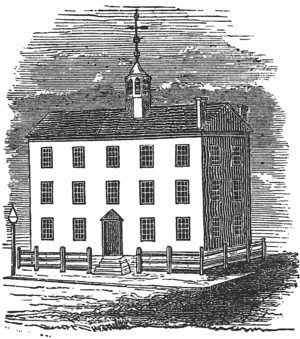
After the war, New York's borders were set. The counties east of Lake Champlain became Vermont. The state's western borders were settled by 1786.
Many Iroquois supported the British. They feared what the Americans might do. Many were killed during the war. Others went into exile with the British. Those who stayed lived on twelve reservations. By 1826, only eight remained. All of these still exist today.
The state adopted its constitution in April 1777. It created a strong governor and clear separation of powers. This constitution greatly influenced the federal constitution ten years later. Debates over the federal constitution in 1787 led to two groups. The Federalists (mostly from New York City) supported a strong national government. The Antifederalists (mostly from upstate) opposed large national institutions. In 1787, Alexander Hamilton, a Federalist from New York, wrote the first essay of the Federalist Papers. He wrote most of the series to support the proposed United States Constitution. New York ratified the Constitution in 1788.
In 1785, New York City became the national capital. It stayed the capital on and off until 1790. George Washington was inaugurated as the first President of the United States there in 1789. The United States Bill of Rights was written there. The United States Supreme Court met for the first time. From statehood until 1797, the Legislature moved the capital often. It was in Albany, Kingston, Poughkeepsie, and New York City. After 1797, Albany became the permanent capital.
In the early 1800s, New York became a leader in transportation. In 1807, Robert Fulton started the first successful steamboat line from New York to Albany. By 1815, Albany was the center for turnpikes. This made it a hub for pioneers moving west to Buffalo and the Michigan Territory.
In 1825, the Erie Canal opened. This made New York economically powerful. It connected the Atlantic Ocean and the Great Lakes. The canal joined different parts of the state. It created a huge economic area for New York City. It also provided a market for farm products from inside the state. Western New York changed from a "frontier" to a settled area. By this time, most counties and towns were formed. In 1831, the Mohawk and Hudson Railroad started the country's first regular train service.
Better transportation led to quick settlement of the fertile Mohawk and Gennessee valleys. Buffalo and Rochester became boomtowns. Many "Yankees" from New England moved to central and western New York. This led to small conflicts with the older "Yorkers" (Dutch, German, Scottish). By 1840, New York had seven of the nation's thirty largest cities.
During this time, towns built schools, even for girls. Western New York was a center for progressive ideas. These included supporting abolitionism (ending slavery), temperance (limiting alcohol), and women's rights. New religious movements also started. The Church of Jesus Christ of Latter-Day Saints (Mormons) was founded in the area by Joseph Smith. Some people who wanted to end slavery helped runaway slaves. They used the Underground Railroad to help slaves reach freedom in Canada or New York.
In the early 1840s, New York laws helped free black people and runaway slaves. In 1840, laws protected African Americans from slave-catchers. One law gave accused runaway slaves the right to a jury trial in New York. Another promised state help to get back free black people who were kidnapped into slavery. Governor William H. Seward also ended a law that allowed slaveholders to bring slaves into the state for nine months. After this, slaves brought to New York were immediately free. Seward also signed a law to create public education for all children.
New York culture grew in the early 1800s. In 1809, Washington Irving wrote A History of New York. In 1819, he set Rip Van Winkle and The Legend of Sleepy Hollow in Hudson Valley towns. Thomas Cole's Hudson River School started in the 1830s. It showed beautiful landscapes of the Hudson Valley. The first baseball teams formed in New York City in the 1840s. Professional baseball later put its Hall of Fame in Cooperstown. Saratoga Race Course, a summer horse racing track, opened in 1847.
New York During the Civil War
A war was not good for business in New York. The state had strong ties to the Deep South. This was through the port of New York and cotton factories upstate. Before the war, half of New York City's exports were related to cotton. Southern businessmen often visited the city. The city's large Democrat community worried about Abraham Lincoln's election in 1860. The mayor even suggested New York leave the Union.
By the time of the 1861 Battle of Fort Sumter, these political differences lessened. New York quickly sent soldiers and supplies when Lincoln asked. Hundreds of thousands of New York's young men fought in the Civil War. This was more than any other Northern state. No battles were fought in New York. But the state was not safe from Confederate plans. These included a plot to burn New York cities and an invasion from Canada.
In January 1863, Lincoln issued the Emancipation Proclamation. This freed slaves in states still fighting against the Union. In March 1863, the federal draft law changed. Men aged 20 to 35 and unmarried men up to 45 had to join the army. Those who could pay $300 or hire someone to take their place were excused. Anti-war newspapers attacked the law. Many immigrants felt it was unfair that rich people could avoid fighting. Democratic leaders warned that freed black people from the South would compete with white workers.
On July 11, 1863, the first draft lottery happened. On July 13, 1863, large-scale riots began. These lasted five days. They were mostly led by Irish immigrants. They attacked black people, their neighborhoods, and people who supported ending slavery. As a result, many black people left Manhattan for good. They moved to Brooklyn or other areas.
From the Civil War to 1900
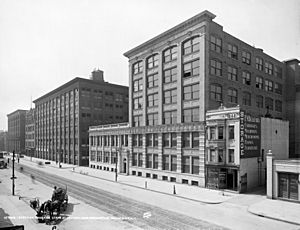
In the decades after the Civil War, New York became even stronger in finance and banking. Manufacturing continued to grow. Well-known companies founded then include Eastman Kodak (1888 in Rochester), General Electric in Schenectady, and Endicott-Johnson Shoe Company. Buffalo and Niagara Falls attracted many factories. This was thanks to hydroelectric power in the area.
As industry grew, workers began to form unions in New York as early as the 1820s. By 1882, the Knights of Labor in New York City had 60,000 members. Trade unions used their power to limit working hours. New York's farm output reached its highest point. Farming changed from growing crops to dairy farming. The cheese industry grew in the Mohawk Valley. By 1881, the state had over 241,000 farms. The area around New York Harbor became the world's oyster capital.
Immigration increased in the late 1800s. Starting with people fleeing the Irish potato famine in the 1840s, New York became a main entry point for immigrants. Between 1855 and 1890, about 8 million immigrants passed through Castle Clinton at Battery Park in Manhattan. Most early immigrants were from Ireland and Germany. Ellis Island opened in 1892. Between 1880 and 1920, most immigrants were from Eastern Europe, including Jews, Poles, and Italians. By 1925, New York City's population was larger than London's. This made it the most populated city in the world.
New York's most famous symbol, the Liberty Enlightening the World, was finished in 1886. It was a gift from France for America's 100th birthday. By the early 1900s, the statue was known as the "Mother of Exiles." It was a symbol of hope for immigrants.
New York's political patterns changed little after the mid-1800s. New York City was mostly Democrat. Upstate New York was Republican and a center for anti-slavery activists. In the 1850s, the Democratic Tammany Hall became a powerful political organization. Boss William Tweed made it very important in city and state politics in the 1860s. Tammany Hall kept its influence until at least the 1930s. Outside the city, Republicans controlled the Legislature by 1894. Both parties have had national success. In 39 presidential elections between 1856 and 2010, Republicans won 19 times and Democrats 20 times.
New York in the Early 1900s and the Great Depression
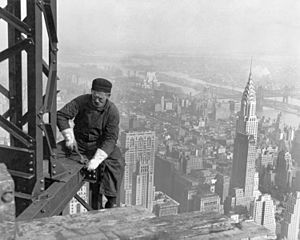
By 1900, New York was the richest and most populated state. Two years before, the five boroughs of New York City became one city. Within decades, the skyscraper became the city's symbol. The Woolworth Building was the tallest building in the world from 1913. It was surpassed by 40 Wall Street in 1930, the Chrysler Building in 1930, the Empire State Building in 1931, and the World Trade Center in 1972.
The state had over a dozen major railroads. In the early 1900s, electric train networks began to appear around Syracuse, Rochester, and other New York cities.
In the late 1890s, Governor Theodore Roosevelt and other Republicans worked with Democrats like Al Smith. They promoted Progressivism. They fought against large companies that controlled industries. They wanted more efficiency and less waste. They also called for more democracy in politics. Democrats focused on how progressivism could help working-class families and labor unions.
Democratic political groups, especially Tammany Hall in Manhattan, were against women getting the right to vote. They feared that women voters would weaken their control over male voters. However, by the time of the New York State vote on women's suffrage in 1917, some wives and daughters of Tammany Hall leaders supported voting rights for women. This led Tammany Hall to take a neutral position, which helped the vote pass.
After a short economic downturn, New York had a booming economy during the Roaring Twenties. New York suffered during the Great Depression. This began with the Wall Street crash in 1929. The Securities and Exchange Commission opened in 1934 to regulate the stock market. Franklin Delano Roosevelt was elected governor in 1928. The state faced over 25% unemployment. His Temporary Emergency Relief Agency, started in 1931, was the first work relief program in the nation. It influenced the national Federal Emergency Relief Administration. Roosevelt was elected President in 1932. This was partly because he promised to expand New York-style relief programs across the country with his New Deal. In 1932, Lake Placid hosted the III Olympic Winter Games.
World War II and Modern New York
As the largest state, New York again provided the most resources during World War II. New York made 11 percent of all United States military weapons during the war. It had 31,215 casualties. The war affected the state socially and economically. For example, Governor Herbert H. Lehman created the Committee on Discrimination in Employment in 1941. Governor Thomas E. Dewey signed the Ives–Quinn bill in 1945, which banned job discrimination. The G.I. Bill of 1944 offered returning soldiers affordable higher education. This forced New York to create a public university system. Its private universities could not handle all the new students. The State University of New York was created by Governor Dewey in 1948.
World War II was New York's last big industrial era. After the war, the defense industry shrank. The economy shifted to producing services instead of goods. Returning soldiers often took jobs from women and minority workers. These workers had only entered factories during the war. Companies moved to the south and west for lower taxes and cheaper, non-union workers. Many workers followed these jobs.
The middle class grew. This led to the creation of suburbs, like those on Long Island. The automobile sped up this spread. Planned communities like Levittown offered affordable homes for the middle class.
Larger cities stopped growing around 1950. Growth only started again in New York City in the 1980s. Buffalo's population fell by half between 1950 and 2000. Less immigration and worker movement caused New York State's population to drop for the first time between 1970 and 1980. California and Texas both became more populated.
New York began its third era of huge transportation projects by building highways. The New York State Thruway was a notable one. This project was not popular with New York City Democrats. They called it "Dewey's ditch" and "the enemy of schools." This was because the Thruway mostly helped upstate New York. The highway was based on the German Autobahn. It was unlike anything seen in the United States at that time. It was within 30 miles (48 km) of 90% of the population when it was planned. The full 427-mile (687 km) project cost $600 million and opened in 1956.
Nelson Rockefeller was governor from 1959 to 1973. He changed New York politics. He started as a liberal but became more conservative. He limited the growth of SUNY. He responded strongly to the Attica Prison riot. He also created the very strict Rockefeller Drug Laws. The World Trade Center and other expensive projects almost caused New York City to go bankrupt in 1975. The state took control of the city's budget. This eventually led to better financial management.
The Governor's Mansion was taken back by Democrats in 1974. It stayed under Democratic control for 20 years with Hugh Carey and Mario Cuomo. Later Democrats became more moderate. These included US Senator Daniel Patrick Moynihan (1977–2001) and New York City Mayor Ed Koch (1978–1989). State Republicans started to align with the more conservative national party. They gained power with the elections of Senator Alfonse D'Amato in 1980, Mayor Rudolph Giuliani in 1993, and Governor George Pataki in 1994. New York remained one of the most liberal states. In 1984, Ronald Reagan was the last Republican to win the state. However, Republican Michael Bloomberg served as New York City mayor in the early 2000s.
New York in the Late 20th Century
In the late 1900s, telecommunication and high technology industries employed many New Yorkers. New York City was especially good at this change. Many small companies were started. Older industrial firms like Polaroid struggled. This success attracted many young professionals to the still-shrinking cities. New York City was an exception and continued to attract new residents. The city's energy created attractions and new businesses. Some believe that changes in policing made the city safer. Crime rates dropped, and urban development reduced urban decay.
This led to a surge in culture. New York City became "the center for all things chic and trendy" again. Hip-hop and rap music, led by New York City, became the most popular music style. Immigration to both the city and state increased. New York City, with a large gay and lesbian community, saw many deaths from AIDS starting in the 1980s.
New York City increased its already large share of television programming. It was home to the network news broadcasts. It also had two of the three major cable news networks. New York also increased its dominance in the financial services industry. This was centered on Wall Street. It was led by banking growth, a rising stock market, and new ideas in investment banking.
Upstate New York did not do as well as downstate. The major industries that helped New York City did not usually spread to other regions. The number of farms in the state fell to 30,000 by 1997. City populations continued to decline. Suburbs grew in area but not as much in population. High-tech industry grew in cities like Corning and Rochester. Overall, New York entered the new millennium "in a position of economic strength and optimism."
New York After September 11, 2001

New York entered a new era after the September 11, 2001 attacks. These were the worst terrorist attacks ever on American soil. Four hijacked passenger jets were flown towards the USA. Two crashed into the World Trade Center, destroying them. Almost 3,000 people died. One plane flew into the Pentagon. The last one was taken back by the pilots and crashed into a field. Thousands of New Yorkers volunteered to search for survivors and remains in the weeks that followed.
After the attacks, plans were made to rebuild the World Trade Center site. 7 World Trade Center was the first skyscraper to be rebuilt. It opened five years after the attacks. One World Trade Center, four more office towers, and a memorial to those who died are now built. One World Trade Center opened on November 3, 2014.
In the State Legislature, most politicians get re-elected. In 2002, only one person in each house lost their re-election. Some experts believe this lack of competition makes it harder for politicians from different parties to work together.
|



